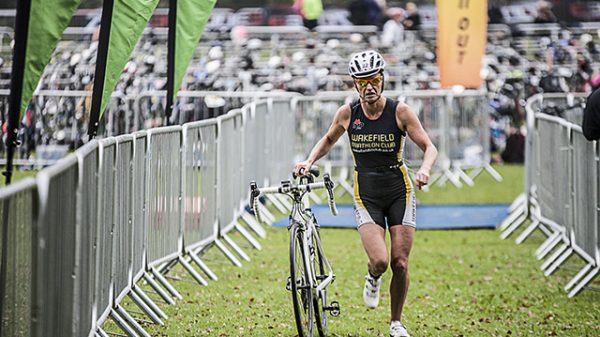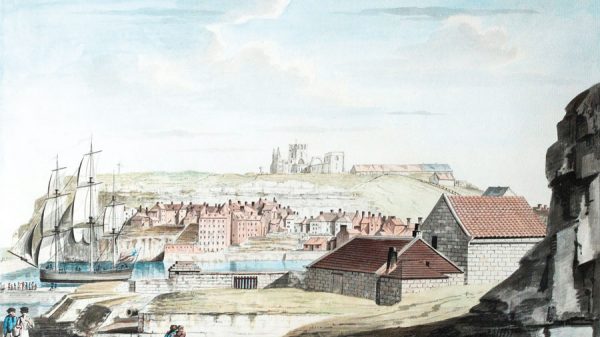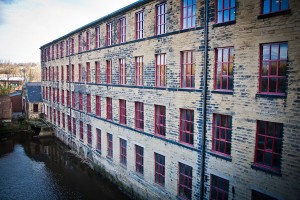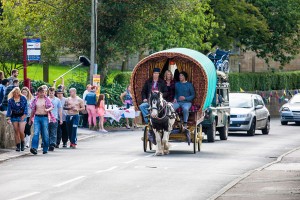With Halloween at the end of this month, kids (and maybe some adults!) are thinking about things that go bump in the night. Costumes and treats are being bought in anticipation, and soon carved pumpkins will be decorating homes. Halloween is a magical time with tales of witches, ghosts and undead creatures that children love to hear.
Over the next few pages, dare to read about Dracula and his arrival in Whitby, haunted places in Yorkshire that will send a shiver down your spine, and ghostly goings on that you can get involved in – if you are brave enough!
Dracula in Whitby
One tale which has both terrified and thrilled people around the globe for more than a century is Bram Stoker’s Dracula. The book has been interpreted in Hollywood blockbusters and it remains as popular today as it always has. And where did Bram Stoker get his inspiration for such a timeless classic? Yorkshire’s very own Whitby of course – which also features in the book. In this month’s feature we look into the events that sparked the imagination of Stoker, and also the historical figure of the real Dracula!
Bram Stoker
Abraham Stoker was born in Ireland 1847, the third of seven children. He began his writing career after graduating from Trinity College, Dublin with Honours for mathematics in 1870. He wrote non-fiction books and theatre production reviews, including one of Henry Irving’s performance of Hamlet in 1876. This review was so favourable that he was invited to dine with the actor and the pair became good friends. Stoker married in 1878 and moved to London to become business manager for Irving’s Lyceum Theatre where he remained for 27 years. This position moved him into influential circles where he met other acclaimed writers of the time such as Sir Arthur Conan Doyle, Oscar Wilde and William Yeats. Stoker’s work with Irving meant he was well travelled and this gave him a rich insight for many of his settings and characters. However, his most famous literary work Dracula was largely inspired by a trip to Whitby in 1890.
The Birth of Bram Stoker’s Dracula
Staying on the West Cliffs at the Royal Hotel gave the author incredible views down into the town and harbour, also to the east side of the town – older cobbled streets, red roofed cottages and of course the imposing ruins of Whitby Abbey behind St Mary’s Church at the top of the cliff. On a brooding, misty day this view would certainly spark ideas of the supernatural and macabre in a creative mind.
During his visit to the town, Bram Stoker visited the library, and his notes suggest this is where he first came across the name Dracula in a general history book. At the top of a sheet of notes reads “William Wilkinson’s ‘An Account of the Principalities of Wallachia and Moldovia’ (1820)” along with “Whitby Library 0.1097” which we assume is the call number for the book. These notes also contain a reference to the historical figure Dracula which is the only one in all his papers.
As well as coming across the name Dracula in the town, Whitby clearly left a lasting impression on the author as it features heavily in the book. Those of you familiar with the book will remember that the tale begins with Jonathan Harker, a newly qualified solicitor visiting Count Dracula in the Carpathian Mountains to provide legal assistance for a real estate transaction. Set upon by three female vampires ‘the sisters’, Harker is abandoned by Dracula who has left Transylvania. The story then arrives in Whitby, England where a mysterious Russian ship, the Demeter runs aground on the shores of Whitby during a storm. There is no crew to be found, and a large dog is seen leaping ashore before disappearing up towards St Mary’s church. Dracula is soon stalking Harker’s fiancée Mina and her friend Lucy in the town. Through Mina’s journal entries there are some wonderful descriptions of Whitby – “The little rover, the Esk, runs through a deep valley, which broadens out as it comes near the harbour. A great viaduct runs across, with high piers, through which the view seems somewhat further away than it really is. The valley is beautifully green and it is so steep that when you are on the high land on either side you look right across it, unless you are near enough to see down.” Another entry describes the Abbey “Right over the town is the ruin of Whitby Abbey, which was sacked by the Danes, and which is the scene of part of ‘Marmion’, where the girl was built up in the wall. It is a most noble ruin, of immense size, and full of beautiful and romantic bits; there is a legend that a white lady is seen in one of the windows.”
Whitby
Whitby is certainly a jewel in Yorkshire’s crown. A wonderfully eccentric little seaside town combining sandy beaches, ice-cream and fish and chips with independent quirky shops selling famous Whitby Jet and the 199 step climb up to the imposing ruins of the Abbey.
The story of Dracula has brought fans flocking to the town for years, and Whitby now has a strong connection with everything gothic.
The Bram Stoker International Film Festival, arriving this year on the 22nd October, is now in its 6th year and has become one of the biggest and most unique genre festivals in the country. It was originally set up to show off Bram Stoker’s influence on horror cinema, but has grown into a celebration of all things dark and macabre through art, music, literature and film.
Twice a year is the Whitby Goth Weekend (WGW). This was set up when a group of around 40 pen pals visited the town in 1994 because of its Dracula connections. This then became an annual event and was growing each year as more and more arrived for the musical entertainment.
The WGW is now on twice a year due to its popularity and is one of the world’s premier Goth events bringing thousands to the town each year. Despite the name, not just goths attend with people from all genres of the alternative lifestyle turning up to enjoy a weekend of music, dancing, drinking and shopping. The next event this year arrives in Whitby on the 30th October.
Film
Of course, as well as bringing thousands of vampire hunting tourists to Whitby each year, Stoker’s novel has also spawned horror films depicting the evil creature. Probably the most famous of these is the 1958 Hammer Horror ‘Dracula’ starring Peter Cushing as Van Helsing and Christopher Lee as Count Dracula.
Filmed in Britain, the movie was a massive hit receiving rave reviews in publications such as one from Film Bulletin in 1958 which said “…..and directed by Terence Fisher with an immense flair for the blood curdling shot, this Technicolor nightmare should prove a real treat. The James Bernard score is monumentally sinister and the Jack Asher photography full of foreboding atmosphere.” The film utilised special effects including a shot where Dracula appears to peel away his decaying skin. This was accomplished by putting a layer of red makeup on Christopher Lee’s face, then covering him with a thin coating of mortician’s wax. When he raked his fingers across the wax it revealed the ‘raw’ marks underneath! Despite Christopher Lee playing numerous roles in films over the years including massive hits such as Star Wars he was always remembered for his dark portrayal of Dracula. He said “I’ve always acknowledged my debt to Hammer. I’ve always said I’m very grateful to them. They gave me this great opportunity, made me a well-known face all over the world for which I am profoundly grateful.” Christopher Lee sadly passed away earlier this year in June.
Another memorable blockbuster is the 1992 Bram Stoker’s Dracula, starring Gary Oldman as Count Dracula, Winona Ryder as Mina, Anthony Hopkins as Van Helsing and Keanu Reeves as Jonathan Harker. The resulting film received mixed reviews, with most enjoying the romantic makeover of Dracula, but many also criticizing Keanu Reeves’ performance. However, for many of a certain generation, the film remains a classic. Sadly, neither of these two classics were filmed in Whitby which surely would have added a little authenticity.
Of course there have been many other film interpretations of Count Dracula, the most recent being Dracula Untold released in 2014 and starring Luke Evans as the title character. This however, focusses not on Bram Stoker’s famous novel, but that of the story of the ‘real’ Dracula.
Who is the real Dracula?
As we have already discovered, Bram Stoker came across the name Dracula in the library at Whitby. But who was he? Not a vampire certainly – the legendary vampire whose name has cast terror into the hearts of many over the decades is of course a purely fictional character. It is highly likely that when Stoker stumbled upon the name, it was referring to Vlad III, better known as Vlad the Impaler.
Vlad III was born in 1431 in what is now the central region of modern day Romania. At this time his father Vlad II was a ‘voivode’ or ruler of the principality of Wallachia. In 1431, Vlad II was inducted into a knightly order, the Order of the Dragon by King Sigismund of Hungary who would go on to become Holy Roman Emperor. This designation earned Vlad the new surname Dracul which came from the old Romanian word for dragon ‘drac’. This meant that Vlad III would later be known as the son of Dracul, or in old Romanian ‘Draculea’ hence Dracula. Incidentally, in modern Romanian, the word ‘drac’ also means the devil.
The Order of the Dragon of which Vlad II was now a part, was singularly devoted to one task – the defeat of the Turkish (or Ottoman Empire). Vlad II’s home of Wallachia was situated between Christian Europe and the Muslim lands of the Ottoman Empire, and as a result was frequently the scene of bloody battles between the two.
In 1442 Vlad II was called to a meeting with Sultan Murad II and he took along his two sons Vlad III and Radu. The meeting was a trap and all three were held hostage. Vlad II was eventually released on the condition that he left his sons behind. Though treated well in captivity, Vlad III was angered by his situation. In 1448, Vlad embarked on a campaign to regain his father’s seat with military support from the Ottoman governors after he was killed. He won back his seat but this was short lived, being deposed after just two months. Little is known about his whereabouts between 1448 and 1456 but we do know that he switched sides in the Ottoman – Hungarian conflict, cutting his ties with the Ottoman governors and obtaining support from King Ladislaus V of Hungary.
In 1456 Vlad was declared Voivode of Wallachia and stopped paying the annual tribute to the Ottoman sultan. He received the name Vlad the Impaler through many stories in contemporary pamphlets and other printed material from the time of his rule. One such story goes that he invited hundreds of boyars to a banquet knowing they would challenge his authority, and had them stabbed and impaled on spikes. Another tale is of him nailing turbans to the skulls of Ottoman envoys after they refused to remove them in his presence.
So, apart from the name, and the bloodthirsty nature there is little in common between the historical Dracula, and Bram Stoker’s fictional character. Unlike Stoker’s Count, Vlad most definitely died, in 1476 when he was ambushed. There is much controversy over the location of his tomb, and only the harrowing tales of his years as ruler of Wallachia remain to haunt the modern world. As to where the Count is these days – who knows? Mwaaahaaahaaa!







